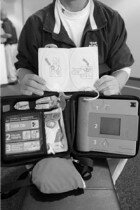City gets life saving devices
 Two-and-a-half years after a 48-year-old Madison man died of a heart attack on a treadmill at Gold's Gym in Culpeper, his widow's vision of placing Automated External Defibrillators, or AEDs, in all public buildings is coming true in Charlottesville. This month, the City began installing the life-saving devices– which deliver an electrical shock to an irregularly beating heart and increase a cardiac arrest victim's survival rate by as much as 85 percent– in public buildings throughout the city, including in schools, rec centers, parks, and City government offices.
Two-and-a-half years after a 48-year-old Madison man died of a heart attack on a treadmill at Gold's Gym in Culpeper, his widow's vision of placing Automated External Defibrillators, or AEDs, in all public buildings is coming true in Charlottesville. This month, the City began installing the life-saving devices– which deliver an electrical shock to an irregularly beating heart and increase a cardiac arrest victim's survival rate by as much as 85 percent– in public buildings throughout the city, including in schools, rec centers, parks, and City government offices. 
"It's awesome," says Susan Murphy, the widow who just weeks before her husband's death in January 2006, called the Hook suggesting an article about AEDs. Her husband, Henry DeJarnette (pictured right), had recently been diagnosed with a congenital heart murmur and heart disease, and Gold's Gym, where the couple worked out daily, had refused to purchase a device, she said, despite her repeated requests.
Less than two weeks after her first call, Murphy called again, this time sobbing. Henry, she said, had suffered a heart attack right in front of her while running on the treadmill at Gold's in Culpeper. She'd left her own AED in the car, and by the time she raced to retrieve it and applied it to her prone husband's chest– she estimates several minutes had elapsed– it was too late. Henry was dead.
The now-remarried Murphy– who was then known as Susan DeJarnette– told her story in a Hook cover story ["Heartbreak: Could a simple device have saved this man's life," February 9, 2006], and urged safety officials and business owners to purchase the approximately $1,000 devices. She pointed to the fact that the devices have been endorsed by the American Heart Association since the early 1990s after research showed that if a victim of cardiac arrest receives defibrillation, the survival rate can reach as high as 90 percent– but only if the shock is administered immediately after the attack.
Charlottesville Fire Chief Charles Werner was one safety official struck by Henry DeJarnette's death. In the months following the article's publication, he and Murphy brainstormed several times and eventually met with state delegate David Toscano to work on legislation to mandate the devices. That effort was unsuccessful.
"We had the legislation drafted, but we never filed it," says Toscano, who explains there wasn't enough support statewide to pass the bill, so he shelved it. Werner says he was frustrated by the failure to introduce the law, so he changed tactics and acted locally. He secured $60,000 of last year's surplus from the city's general budget– enough to purchase and install 55 of the devices, train staff in every location and maintain the equipment for the next two years. In addition, Werner says, he's considering various plans to reward private businesses that voluntarily install AEDs and train their staff. Among his ideas: a city-paid ad campaign praising such businesses.
Already, the major local health clubs have AEDs (ACAC's is pictured above). Gold's Gym, which didn't have AEDs, finally purchased one for each of its two local locations– Charlottesville and Culpeper– after the Hook article ran in 2006. Large music venues including the Paramount and John Paul Jones Arena also both have the devices, as does the airport.
Albemarle County has AEDs in a few public spaces, according to Fire Chief Dan Eggleston, although the AED program is not as extensive as Charlottesville's new plan. Eggleston names the County Office Building as one location with an AED, and he says that some schools may have them but that there is not yet any organized effort to place them in every public building.
Murphy says she's encouraged by Charlottesville's new program, and she hopes other localities will follow the city's lead. Even more critical than placement in public spaces, she believes, is convincing all private businesses to invest in the devices.
"It would be nice someday to imagine that every restaurant would open up and have one, that every theater would have one," she says. "It should be like having a first aid kit."